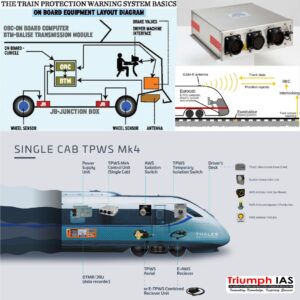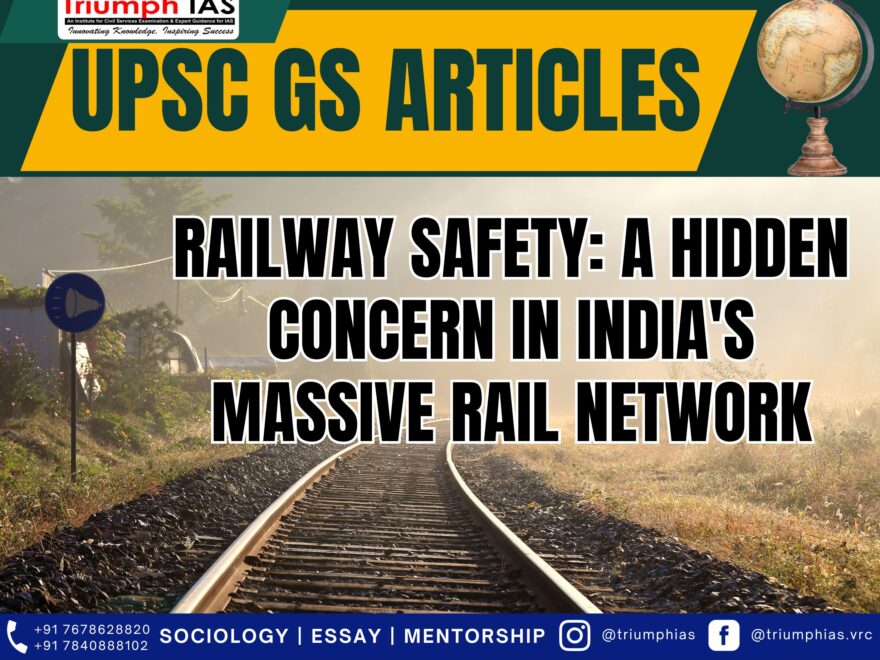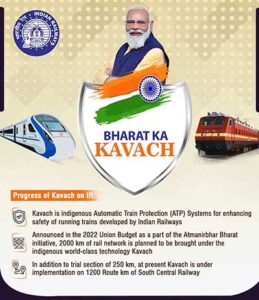Railway Safety: A hidden concern
(Relevant for General Studies Paper | Infrastructure | Econo| Prelims/Mains)

Railway Safety: A hidden concern
The Indian Railways safety stands as one of the largest railway networks globally, serving millions of individuals as their primary mode of transportation daily. Data indicates a significant reduction in derailments, the predominant cause of accidents, over the past two decades—from approximately 350 annually at the turn of the millennium to 22 in 2021-22.
Despite this positive trend, tragic events like the one at Bahanaga Bazar railway station in Balasore underscore the imperative for enhanced safety measures and infrastructure. The loss of numerous lives serves as a poignant reminder of the critical need to ensure the railways’ safety for all passengers.
In the aftermath of this incident, there are widespread calls for accountability from railway authorities and a demand to address underlying systemic issues contributing to such accidents. Experts are advocating for preventive measures, including the enhancement of signalling systems and investments in advanced technology to avert similar incidents in the future.
Comparisons with international railway safety systems have been drawn, emphasizing the necessity for India to elevate its infrastructure and safety protocols to match global standards. In summary, this incident has spotlighted the vital significance of guaranteeing the safety and dependability of the Indian Railways for all its users.
Primary Reasons behind Railway Accidents
- Infrastructure Deficiencies: The railway safety infrastructure, encompassing tracks, bridges, overhead wires, and rolling stock, often exhibits defects stemming from inadequate maintenance, ageing, vandalism, sabotage, or natural calamities. A considerable portion of this infrastructure was constructed in the 19th and 20th centuries and has not undergone upgrades to meet burgeoning demand and contemporary standards. Insufficient funds, corruption, and inefficiency further impede the development and upkeep of the railway system. Additionally, numerous routes operate at over 100% capacity, escalating the risk of accidents due to congestion and overloading.
- Human Fallibility: Railway safety personnel, tasked with operating, maintaining, and overseeing trains and tracks, are susceptible to human errors caused by fatigue, negligence, corruption, or a lack of adherence to safety protocols. Such errors may manifest in incorrect signalling, miscommunication, speeding violations, or oversight of defects or hazards. The inadequacy of training and communication skills among railway staff further impacts their performance and coordination.
- Signal Failures: The signalling system, responsible for regulating the movement and direction of trains on the tracks, can experience failures due to technical glitches, power outages, or human errors. Signal malfunctions may lead to trains running on the wrong track, collisions with other trains or stationary objects, or overshooting stations. For instance, the recent train accident in Odisha was purportedly caused by a change in electronic interlocking that was not effectively communicated to the drivers.
- Unmanned Level Crossings (UMLCs): UMLCs, where railway tracks intersect roads without barriers or signals to control traffic, pose a significant accident risk. Vehicles or pedestrians may fail to notice approaching trains or attempt to cross the track when a train is in close proximity. In the fiscal year 2018-19, UMLCs contributed to 16% of all train accidents in India. While unmanned level crossings on broad gauge routes have been eliminated, there remain manned level crossings that continue to pose a risk of accidents.
Steps taken to reduce railway accidents
- Rashtriya Rail Sanraksha Kosh (RRSK): A safety fund dedicated to critical assets. Established in the fiscal year 2017-18, it boasts a corpus of Rs 1 lakh crore spread over five years. The fund is allocated for essential safety-related projects such as track renewals, signalling initiatives, bridge rehabilitation, and more.
- Technological Advancements: Enhancements in the design and features of coaches and wagons. This involves the introduction of Modified Centre Buffer Couplers, Bogie Mounted Air Brake System (BMBS), improved suspension design, and the incorporation of an Automatic Fire & Smoke Detection system in coaches. Additionally, the deployment of KAVACH, an indigenously developed Automatic Train Protection (ATP) system, is part of this initiative.
- LHB Design Coaches: Adoption of lighter and safer coaches for Mail/Express trains. These coaches, based on German technology, feature superior anti-climbing attributes, fire-retardant materials, higher speed potential, and an extended service life compared to conventional ICF design coaches.
- GPS-Based Fog Pass Device: A device designed to assist loco pilots in navigating foggy conditions. This GPS-enabled handheld device provides real-time information on approaching landmarks, such as signals and level crossing gates. It also issues loud alerts to the loco pilot when the train is approaching a signal or a level crossing gate.
- Modern Track Structure: Implementation of robust and durable tracks and bridges. This includes the utilization of Prestressed Concrete Sleepers (PSC), rails with higher Ultimate Tensile Strength (UTS), fan-shaped layout turnout on PSC sleepers, Steel Channel Sleepers on girder bridges, and more.
- Ultrasonic Flaw Detection (USFD): Adoption of a technique to identify and rectify faulty rails. This non-destructive testing method employs high-frequency sound waves to inspect rails for cracks, defects, or flaws that might lead to derailments or accidents. Faulty rails identified through this process are replaced with new ones.
- Mechanization of Track Maintenance: Implementation of a system to automate and optimize track maintenance. This involves the use of machines like track tamping machines, ballast regulating machines, dynamic track stabilizers, etc., to conduct track maintenance activities such as tamping, dressing, stabilizing, and more. This reduces human errors, improving track quality and safety.
- Interlocking System: Introduction of a system to centrally control points and signals. This system employs electrical or electronic devices to operate points and signals from a central location, eliminating the need for manual ground-level operation by staff. This not only reduces the likelihood of human error but also enhances safety.
- Elimination of Unmanned Level Crossings (UMLCs): Progressive elimination of UMLCs through closures, mergers, manning, or the provision of subways/road under bridges/road over bridges.
Committees recommendations
|
What can be done to reduce railway accidents
- Invest More in Safety-Related Initiatives: Allocate additional funds for track renewal, bridge maintenance, signalling upgrades, and coach refurbishment.
- Train Employees to Minimize Errors: Provide regular and comprehensive training to railway staff on the latest technologies, equipment, systems, safety protocols, and procedures.
- Eliminate Level Crossings: Construct Road overbridges (ROBs) or road underbridges (RUBs) to replace both unmanned and manned level crossings.
- Adopt Advanced Technologies: Install anti-collision devices (ACDs) like Kavach/Train Collision Avoidance System (TCAS), Train Protection Warning System (TPWS), Automatic Train Control (ATC), etc. The implementation of these technologies is underway on certain sections of tracks and needs expansion to cover the entire network.
- Introduce Performance-Linked Incentives: Implement a reward system for railway staff based on their performance and adherence to safety regulations.
Outsource Non-Core Work: Delegate non-core activities, such as maintaining hospitals and colleges, to private or public sector entities to enhance efficiency and reduce costs.
- Establish a Statutory Railway Safety Authority: Create a railway safety authority as a statutory body with the authority to set safety standards, conduct safety audits and inspections, enforce accountability and penalties for lapses, and investigate accidents.
- Conduct Regular Safety Audits and Inspections: Monitor, evaluate, and audit the safety performance of railway staff, infrastructure, and equipment. Enforce strict accountability and penalties for any lapses.
- Enhance Coordination and Communication: Improve communication and coordination among the railway board, zonal railways, divisions, production units, research organizations, etc., involved in railway operations.
- Establish a Confidential Incident Reporting and Analysis System (CIRAS): Implement a mechanism, similar to the one developed by a British University, encouraging lower-level staff to report deviations in real-time while maintaining confidentiality. Support this system with the necessary communication and information technology infrastructure to make it accessible and user-friendly for all staff members.
- Simultaneously, shift the management mindset from a fault-finding and punishment-oriented approach to one that emphasizes shared commitment to railway safety. Focus on correction rather than punishment, actively listening to the voices of staff at all levels.
- Rethink the Indian Railways Management Service (IRMS) Scheme: Conduct a thorough evaluation of the IRMS scheme and its impact on loyalty, ownership, and safety management. Consider revising or modifying the scheme to maintain a sense of specialization and loyalty towards specific disciplines or departments, promoting a stronger commitment to safety.
Reference The Hindu
Related Blogs…
 |
 |
Frequently Asked Questions:
1. Question: What are the primary reasons behind railway accidents in India?
Answer: The primary reasons behind railway accidents in India include infrastructure deficiencies, human fallibility, signal failures, and unmanned level crossings.
2. Question: What is the Rashtriya Rail Sanraksha Kosh (RRSK), and how does it contribute to railway safety?
Answer: RRSK is a safety fund dedicated to critical railway assets, allocated for safety-related projects like track renewals, signalling initiatives, and bridge rehabilitation, aiming to enhance railway safety.
3. Question: Name one technological advancement introduced to improve railway safety in India.
Answer: The introduction of the GPS-Based Fog Pass Device is one technological advancement to assist loco pilots in navigating foggy conditions and enhance safety.
4. Question: What is the significance of establishing a Railway Safety Authority as recommended by the Kakodkar Committee?
Answer: The Railway Safety Authority would set safety standards, conduct audits, enforce accountability, and investigate accidents, ensuring a safer railway system.
5. Question: How can Indian Railways enhance safety through the adoption of advanced technologies?
Answer: Indian Railways Safety can enhance safety by implementing anti-collision devices like Kavach/Train Collision Avoidance System (TCAS), Train Protection Warning System (TPWS), and Automatic Train Control (ATC) across the network.
GS Related Practices Questions…
To master these intricacies and fare well in the Sociology Optional Syllabus, aspiring sociologists might benefit from guidance by the Best Sociology Optional Teacher and participation in the Best Sociology Optional Coaching. These avenues provide comprehensive assistance, ensuring a solid understanding of sociology’s diverse methodologies and techniques.
META TAGS:
Railway Safety, Indian Railways, infrastructure deficiencies, human fallibility, signal failures, unmanned level crossings, Rashtriya Rail Sanraksha Kosh, technological advancements, LHB design coaches, GPS-based fog pass device, modern track structure, committees recommendations, railway safety, reducing railway accidents, safety-related initiatives, advanced technologies, performance-linked incentives, railway safety authority, safety audits, confidential incident reporting, IRMS scheme

Why Vikash Ranjan’s Classes for Sociology?
Proper guidance and assistance are required to learn the skill of interlinking current happenings with the conventional topics. VIKASH RANJAN SIR at TRIUMPH IAS guides students according to the Recent Trends of UPSC, making him the Best Sociology Teacher for Sociology Optional UPSC.
At Triumph IAS, the Best Sociology Optional Coaching platform, we not only provide the best study material and applied classes for Sociology for IAS but also conduct regular assignments and class tests to assess candidates’ writing skills and understanding of the subject.
Choose The Best Sociology Optional Teacher for IAS Preparation?
At the beginning of the journey for Civil Services Examination preparation, many students face a pivotal decision – selecting their optional subject. Questions such as “which optional subject is the best?” and “which optional subject is the most scoring?” frequently come to mind. Choosing the right optional subject, like choosing the best sociology optional teacher, is a subjective yet vital step that requires a thoughtful decision based on facts. A misstep in this crucial decision can indeed prove disastrous.
Ever since the exam pattern was revamped in 2013, the UPSC has eliminated the need for a second optional subject. Now, candidates have to choose only one optional subject for the UPSC Mains, which has two papers of 250 marks each. One of the compelling choices for many has been the sociology optional. However, it’s strongly advised to decide on your optional subject for mains well ahead of time to get sufficient time to complete the syllabus. After all, most students score similarly in General Studies Papers; it’s the score in the optional subject & essay that contributes significantly to the final selection.
“A sound strategy does not rely solely on the popular
Opinion of toppers or famous YouTubers cum teachers.”
It requires understanding one’s ability, interest, and the relevance of the subject, not just for the exam but also for life in general. Hence, when selecting the best sociology teacher, one must consider the usefulness of sociology optional coaching in General Studies, Essay, and Personality Test.
The choice of the optional subject should be based on objective criteria, such as the nature, scope, and size of the syllabus, uniformity and stability in the question pattern, relevance of the syllabic content in daily life in society, and the availability of study material and guidance. For example, choosing the best sociology optional coaching can ensure access to top-quality study materials and experienced teachers. Always remember, the approach of the UPSC optional subject differs from your academic studies of subjects. Therefore, before settling for sociology optional, you need to analyze the syllabus, previous years’ pattern, subject requirements (be it ideal, visionary, numerical, conceptual theoretical), and your comfort level with the subject.
This decision marks a critical point in your UPSC – CSE journey, potentially determining your success in a career in IAS/Civil Services. Therefore, it’s crucial to choose wisely, whether it’s the optional subject or the best sociology optional teacher. Always base your decision on accurate facts, and never let your emotional biases guide your choices. After all, the search for the best sociology optional coaching is about finding the perfect fit for your unique academic needs and aspirations.
To master these intricacies and fare well in the Sociology Optional Syllabus, aspiring sociologists might benefit from guidance by the Best Sociology Optional Teacher and participation in the Best Sociology Optional Coaching. These avenues provide comprehensive assistance, ensuring a solid understanding of sociology’s diverse methodologies and techniques. Sociology, Social theory, Best Sociology Optional Teacher, Best Sociology Optional Coaching, Sociology Optional Syllabus.
Best Sociology Optional Teacher, Sociology Syllabus, Sociology Optional, Sociology Optional Coaching, Best Sociology Optional Coaching, Best Sociology Teacher, Sociology Course, Sociology Teacher, Sociology Foundation, Sociology Foundation Course, Sociology Optional UPSC, Sociology for IAS,
Follow us :
🔎 https://www.instagram.com/triumphias
🔎https://www.youtube.com/c/TriumphIAS
https://t.me/VikashRanjanSociology
Find More Blogs
| Compare and contrast Karl Marx’s and Max weber’s | Karl Marx- Historical Materialism |
| Talcott Parsons : Social system | Scope of the subject and comparison with other social sciences |




